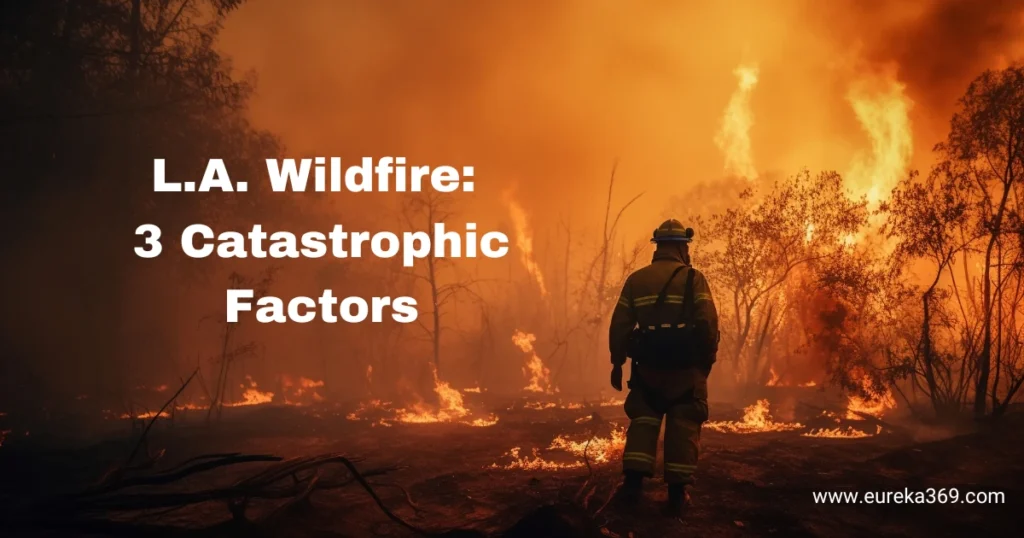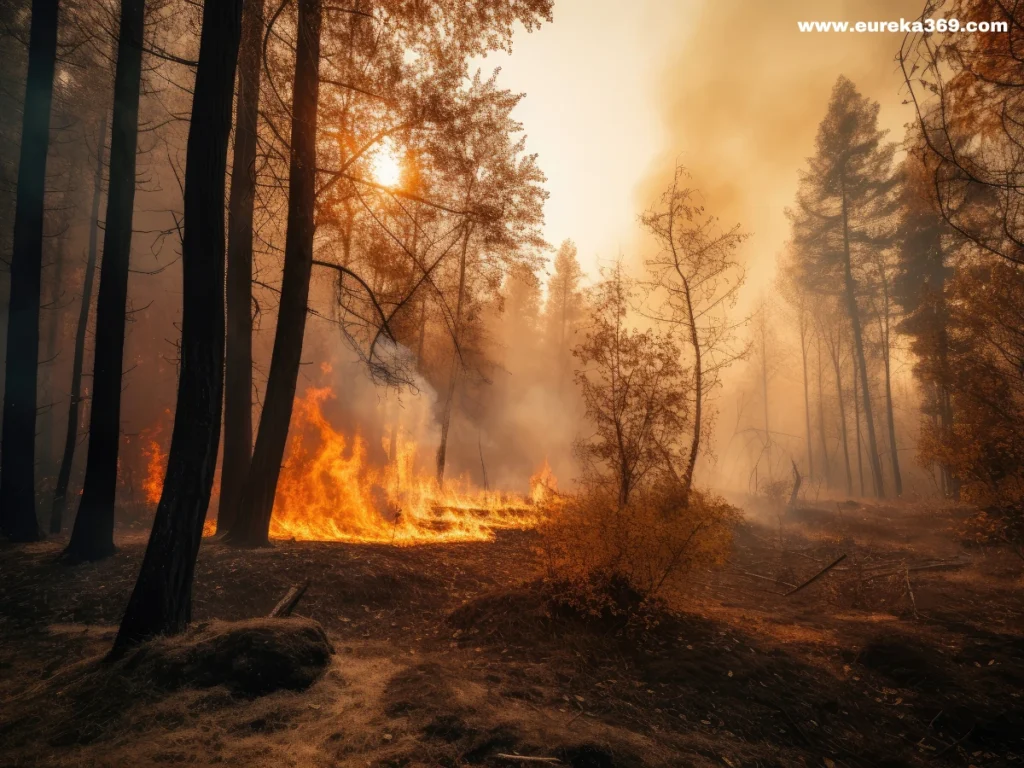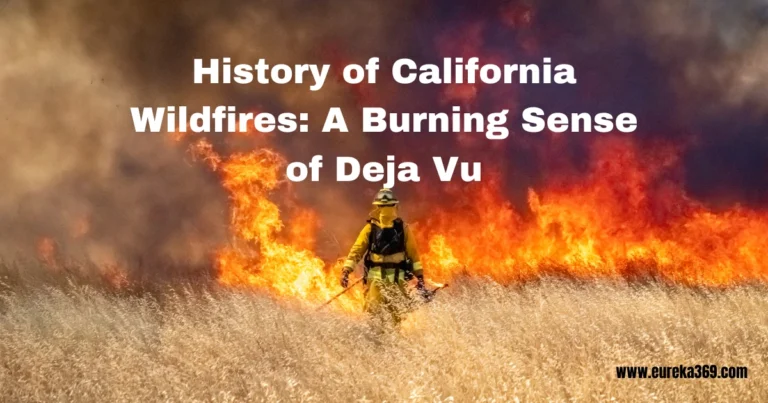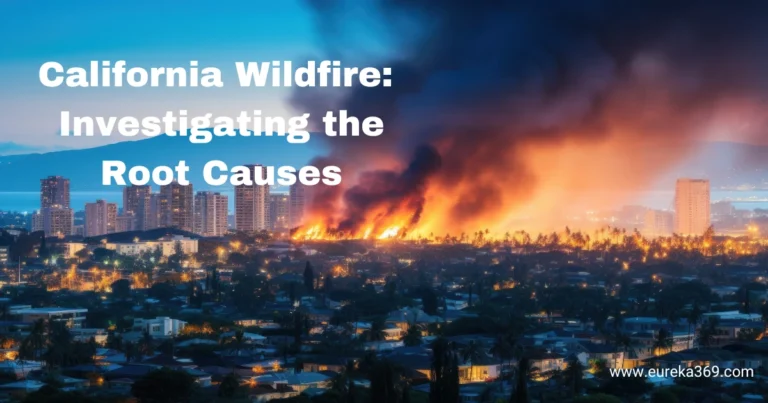“The state’s efforts to reduce greenhouse gas emissions are often undermined by the massive carbon releases from wildfires, which are not accounted for in emissions targets. This underscores the importance of integrating wildfire management into broader climate policies.”

California wildfire in 2025 have been particularly devastating, affecting various regions across the state. Areas like Los Angeles and Southern California have seen significant destruction, with experts attributing the rapid spread of these fires to a combination of climate change, drought, and high winds.
In Los Angeles, the Palisades and Eaton fires have become some of the most destructive in the region’s history.
David Demeritt, a professor of Earth and Environment, emphasize that the combination of Santa Ana winds and prolonged drought conditions creates a perfect storm for wildfires.
These winds can reach speeds of up to 100 mph, rapidly spreading flames and making firefighting efforts extremely challenging.
In recent years, California has experienced some of its most severe fire seasons, with the 2020 season alone causing over $19 billion in economic losses and contributing significantly to greenhouse gas emissions. Climate change exacerbates wildfires by creating hotter and drier conditions, which are ideal for fire ignition and spread. This is evident in regions like Southern California, where drought-like conditions and powerful winds have fueled recent wildfires. Experts emphasize that addressing climate change is crucial to mitigating the impact of wildfires.
Dr. Miriam Marlier notes that even if vegetation regrows, the immediate carbon emissions from wildfires will hinder efforts to meet emission reduction targets.
Drought and the Fueling of California Wildfire
Drought conditions in California are a major factor in the severity of wildfires. The state’s droughts have accelerated in recent years, with the current drought outpacing the devastating 2012-2016 drought. Droughts dry out vegetation, turning it into highly flammable material that can ignite and spread fires quickly. This situation is compounded by climate change, which increases evaporation rates and disrupts atmospheric circulation, leading to reduced rainfall and earlier snowmelt.
Karla Nemeth, the director of the California Department of Water Resources, highlight the unprecedented nature of the current drought, noting that severe conditions are now occurring earlier in the drought cycle.
The impact of drought on wildfires is evident in areas like Los Angeles, where dry conditions have led to rapid fire spread despite relatively calm winds. Addressing drought through sustainable water management and climate resilience strategies is essential to reducing wildfire risks.
Hotter, Drier, Wilder: Climate Change and California Wildfire
Climate change is transforming California’s climate into a hotter and drier environment, which is conducive to wildfires. Rising temperatures increase the likelihood of fire ignition and spread by drying out vegetation and creating conditions that are ripe for combustion. This trend is expected to continue, with climate models predicting more frequent and intense heatwaves and droughts.
In regions like the Sierra Nevada, warmer temperatures are leading to earlier snowmelt, reducing the snowpack that typically supplies water to reservoirs during the dry summer months. This not only exacerbates drought conditions but also increases the risk of wildfires.
California Wildfires: The Role of Rising Temperatures
Rising temperatures are a key factor in the intensification of California wildfire.
Warmer air holds more moisture, leading to increased evaporation and drying of vegetation. This creates a tinderbox effect, where fires can ignite and spread rapidly. The impact of rising temperatures is particularly pronounced in areas with dense vegetation, such as forests and shrublands.
In regions like Northern California, the combination of rising temperatures and changing land use patterns has led to more severe wildfires. Addressing rising temperatures through climate mitigation strategies is crucial to reducing the risk and impact of wildfires.
Drought-Stricken California: A Tinderbox for Wildfires
California’s drought-stricken landscapes are highly susceptible to wildfires. The drought conditions, exacerbated by climate change, turn vegetation into dry fuel that can ignite easily. This situation is further complicated by the state’s hydroclimate variability, which can shift rapidly from wet to dry conditions, creating an environment ripe for wildfires.
In areas like Southern California, the rapid transition from wet winters to dry summers has led to an abundance of dry vegetation, which serves as fuel for wildfires. Experts emphasize the need for adaptive management strategies to address drought and reduce wildfire risks. This includes improving water conservation practices and enhancing vegetation management to reduce fuel loads.
Climate Change: Exacerbating the California Wildfire Threat
Climate change is exacerbating the threat of California wildfire by altering precipitation patterns, increasing temperatures, and creating more extreme weather events.
“The state’s natural variability, including El Niño and La Niña cycles, is also influenced by climate change, leading to more unpredictable and severe weather conditions. “
In regions like Los Angeles, climate change has increased the overlap between dry vegetation conditions and wind events, making wildfires more frequent and intense.
The Impact of Climate Change on California Wildfires
Climate change has a profound impact on California wildfires, affecting both their frequency and intensity. By altering atmospheric circulation and disrupting storm tracks, climate change leads to reduced rainfall and earlier snowmelt, exacerbating drought conditions. This, in turn, creates an environment that is highly susceptible to wildfires.
In areas like the Sierra Nevada, climate change has reduced snowpack, leading to earlier snowmelt and decreased water supply during the dry season. This not only affects agriculture and urban water supplies but also increases the risk of California wildfire by drying out vegetation. Experts emphasize that addressing climate change is essential to mitigating the impact of wildfires on ecosystems and communities.
You can also check out this video on California wildfire: Los Angeles, South California Wildfires Explained or watch below:
California Wildfires: A Burning Issue of Climate Change
California wildfires are a pressing issue that highlights the urgent need to address climate change. The state’s efforts to reduce greenhouse gas emissions are often undermined by the massive carbon releases from wildfires, which are not accounted for in emissions targets. This underscores the importance of integrating wildfire management into broader climate policies.
In regions like Northern California, the impact of wildfires on local ecosystems and communities is significant, with fires affecting not only human settlements but also natural habitats like sequoia forests. Experts stress that a comprehensive approach to climate change must include strategies for mitigating and adapting to wildfires, such as sustainable land management and climate-resilient infrastructure.
Climate Change and the Intensification of California Wildfires
Climate change is intensifying California wildfires by creating conditions that are conducive to fire ignition and spread. Rising temperatures, reduced rainfall, and increased wind events all contribute to the severity of wildfires.
“In areas like Southern California, the combination of drought-like conditions and powerful winds has led to rapid fire spread and devastating impacts. “
Addressing this requires a multifaceted approach that includes climate mitigation, sustainable land use practices, and enhanced emergency preparedness.
Understanding the Climate Connection: California Wildfires,
The impact of climate change on California wildfires is profound and multifaceted. As the climate continues to change, the state will likely experience more frequent and intense wildfires. This reality poses significant challenges for firefighting efforts, as resources may become stretched thin during peak fire seasons.
Moreover, the ecological consequences of California wildfires can be devastating. Wildlife habitats are destroyed, and air quality. Natural variability, such as El Niño and La Niña cycles, impacts rainfall patterns, contributing to drought conditions.
California’s wildfires in 2025 are primarily driven by climate change, characterized by prolonged drought, reduced rainfall, and heavy winds. These conditions create a perfect storm for wildfires, making them more frequent and intense. Solutions include improved forest management, public education on fire safety, and efforts to mitigate climate change through sustainable practices.
The Role of Less Rain in California Wildfires
Reduced rainfall is a significant factor contributing to the increasing frequency and intensity of wildfires in California. The state has experienced erratic precipitation patterns, with some areas receiving heavy rainfall while others suffer from prolonged dry spells. Hence, this inconsistency leads to the accumulation of dry vegetation, which serves as fuel for wildfires. In regions like Los Angeles, the rapid shift from wet to dry conditions, known as hydroclimate whiplash, has created an environment ripe for wildfires.
Impact of Reduced Rainfall

Less moisture in the soil and vegetation makes landscapes more susceptible to ignition. Dry conditions can lead to the rapid spread of fires once they start.
Prolonged Drought Conditions: A Catalyst for Wildfires
Prolonged drought conditions have turned California into a tinderbox, where the lack of moisture creates an environment ripe for wildfires. The state has faced numerous droughts over the past few decades, leading to dry landscapes that are highly flammable.
Consequences of Drought
Stressed vegetation becomes more vulnerable to pests and diseases, further weakening the ecosystem. Drought conditions can lead to increased human activity in fire-prone areas, raising the risk of accidental ignitions.
Heavy Winds: The Accelerant of Wildfires
Heavy winds, particularly the Santa Ana winds in Southern California, play a crucial role in exacerbating wildfire conditions. These winds can reach speeds of up to 100 mph, rapidly spreading flames and complicating firefighting efforts.
Effects of High Winds
Winds can carry embers over long distances, igniting new fires and making containment difficult. The combination of dry vegetation and strong winds creates a volatile environment, increasing the likelihood of catastrophic wildfires.
Solutions to Combat Climate Change and Wildfires
Addressing the root causes of climate change and implementing effective wildfire management strategies are essential for reducing the risk of future wildfires in California.
Improved Forest Management
Thinning out dense vegetation and creating firebreaks can help reduce the intensity of wildfires. Controlled burns can limit available fuel and reduce fire intensity, although they require specific weather conditions for safe implementation.
Public Education and Awareness:
Raising awareness about fire safety measures can help reduce the likelihood of human-caused wildfires. Community engagement in fire prevention strategies is crucial, especially during periods of drought.
Mitigating Climate Change:
Investing in renewable energy sources and reducing carbon emissions can help address the broader issue of climate change. Implementing sustainable land management practices can improve resilience against wildfires.
California wildfires are a complex issue deeply intertwined with climate change. Addressing the root causes of reduced rainfall, prolonged droughts, and heavy winds requires a comprehensive approach that includes climate mitigation, sustainable land use, and enhanced emergency preparedness.
By understanding these connections and implementing effective strategies, California can work towards reducing the impact of wildfires and creating a more resilient future.
Frequently Asked Questions
1. What areas are currently affected by the wildfires?
- Major fires are impacting Los Angeles, particularly in the Pacific Palisades and Eaton Canyon areas.
- Many neighborhoods remain under evacuation orders due to ongoing fire threats.
2. How can I find real-time updates on the wildfires?
- CAL Fire: Offers a map of current fires and updates on fire conditions.
- Local Fire Departments: Follow their social media for immediate updates.
3. What assistance is available for those affected by the wildfires?
- Individuals can apply for disaster assistance through:
- DisasterAssistance.gov
- Calling 800-621-3362
- Using the FEMA smartphone application.
4. How can I help those impacted by the wildfires?
- Participate in community relief efforts by:
- Donating goods through organized drives.
- Contributing to fundraising efforts, such as GoFundMe campaigns for affected individuals.
5. What health risks are associated with the wildfires?
- Smoke from the fires can significantly impact air quality, leading to health concerns.
- Resources for monitoring air quality are available through UCR’s Environmental Health & Safety and the EPA’s Air Now website.
6. What should I do if I receive an evacuation order?
- Follow local authorities’ instructions and evacuate immediately if ordered.
- Ensure you have essential items ready, including medications, important documents, and personal belongings.
7. Are there any long-term impacts expected from these wildfires?
- Experts anticipate long-term effects on physical and mental health for residents.
- Concerns include degraded water quality and potential mudslides in burned areas.
Conclusion
The interplay of reduced rainfall, prolonged drought conditions, and heavy winds creates a challenging environment for L.A., leading to increasingly severe wildfires. This complex situation is exacerbated by climate change, which alters precipitation patterns, increases temperatures, and intensifies weather events like the Santa Ana winds.
By addressing the root causes of droughts and wind events, communities can work towards reducing the risk of wildfires and protecting both their homes and ecosystems.
Implementing effective solutions requires a multifaceted approach that includes climate resilience strategies, sustainable land management, and enhanced emergency preparedness. Communities can benefit from initiatives like the Firewise USA program, which promotes collaborative efforts to enhance California wildfire resilience by improving home conditions and surrounding ignition zones.
Additionally, enforcing defensible space regulations, as seen in Los Angeles, can significantly reduce the risk of fire ignition and spread. Furthermore, investing in prescribed burns and cultural burning practices can help restore a lower intensity fire regime in wildlands, reducing the likelihood of catastrophic wildfires.
By adopting these strategies and working collectively, communities can effectively reduce the impact of climate change on California wildfire and create a safer, more resilient future for L.A. and beyond. This proactive approach not only protects lives and property but also preserves the natural beauty and biodiversity of California’s ecosystems. Also check out Los Angeles Wildfire 2025: Investigating the Root Causes. Where I have thoroughly investigated the root causes and provided practical solutions to mitigate those factors.
Moreover, If you would like to read more about Ecosystems then I highly recommend this good read on The Hidden World: Ecosystem that Rivals Rainforests.
-
[…] California wildfires have been a recurring and devastating phenomenon throughout the state’s history. Over the past century, these fires have grown in frequency and severity, impacting numerous communities and ecosystems. […]



Leave a Reply